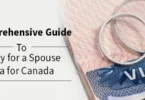Want to explore Europe? Perhaps, you might be dreaming of exploring the charming streets of Paris, the historic ruins of Rome, or the stunning fjords of Norway? Before you pack your bags, you’ll need to get know about the process of obtaining a Schengen visa. In this article, we will discuss the step-by-step guide to make your Schengen visa application process smooth and stress-free.
What is a Schengen Visa?
A Schengen visa is a short-stay visa that allows you to travel to any of the 26 countries in the Schengen Area for up to 90 days within a 180-day period. This visa is essential for non-European travelers who want to explore multiple European countries without the hassle of multiple visas.
Importance of a Schengen Visa
Having a Schengen visa opens up a world of opportunities for travelers. It not only simplifies your travel plans by allowing you to visit several countries with a single visa but also gives you access to some of the world’s most iconic destinations.
Types of Schengen Visas
Short-Stay Visa (Type C)
This is the most common type of Schengen visa, perfect for tourists, business travelers, and those visiting family or friends. It allows you to stay in the Schengen Area for up to 90 days.
Long-Stay Visa (Type D)
If you plan to stay in the Schengen Area for more than 90 days, you will need a long-stay visa. This type is suitable for students, workers, or those relocating for family reasons.
Airport Transit Visa (Type A)
For travelers who need to transit through a Schengen country airport without entering the country, the airport transit visa is necessary.
Eligibility Criteria
Who Needs a Schengen Visa?
Citizens of non-European countries generally require a Schengen visa to enter the Schengen Area. This includes travelers from Asia, Africa, the Americas, and other regions.
Exemptions from Schengen Visa
Nationals of some countries, like the US, Canada, Australia, and Japan, can enter the Schengen Area without a visa for short stays, typically up to 90 days within a 180-day period.
Required Documents
Application Form
The first step in your Schengen visa application is to fill out the application form. Ensure all details are accurate and complete.
Passport Requirements
Your passport must be valid for at least three months beyond your planned departure date from the Schengen Area and must have been issued within the last 10 years. It should also have at least two blank pages.
Photographs
You will need two recent passport-sized photographs that meet the Schengen visa photo requirements.
Travel Insurance
You must have travel insurance with a minimum coverage of €30,000 for medical emergencies, including repatriation, valid for the entire Schengen Area.
Proof of Accommodation
Provide proof of accommodation for your entire stay in the Schengen Area. This could be hotel bookings, a rental agreement, or an invitation from a host.
Financial Means
You need to show proof that you have sufficient funds to cover your stay. This can include bank statements, proof of income, or a letter of sponsorship.
Flight Itinerary
Submit a copy of your round-trip flight reservation or a detailed travel itinerary.
Step-by-Step Application Process
Determine Your Visa Type
Decide which type of Schengen visa suits your travel purpose: short-stay, long-stay, or airport transit.
Locate the Nearest Consulate or Embassy
Find the consulate or embassy of the Schengen country you will be spending the most time in or your main destination.
Schedule an Appointment
Book an appointment for your visa application at the consulate or embassy. Some countries offer online appointment scheduling.
Fill Out the Application Form
Carefully fill out the Schengen visa application form, ensuring all information is accurate and complete.
Gather Necessary Documents
Collect all required documents, making sure they meet the specific requirements of the consulate or embassy.
Attend the Visa Interview
Be prepared for your visa interview. Dress appropriately and answer all questions honestly and clearly.
Pay the Visa Fee
Pay the visa application fee, which is usually non-refundable, regardless of the outcome of your application.
Wait for Processing
The processing time for a Schengen visa is typically 15 calendar days, but it can take longer in some cases.
Common Mistakes to Avoid
Incomplete Application Form
Ensure your application form is fully completed and signed. Incomplete forms can lead to delays or rejection.
Insufficient Financial Proof
Provide clear evidence of your financial stability to avoid any doubts about your ability to support yourself during your stay.
Invalid Travel Insurance
Make sure your travel insurance meets all the Schengen requirements. Invalid insurance can result in application denial.
Processing Time and Fees
Standard Processing Time
The standard processing time for a Schengen visa is up to 15 days, but it can vary depending on the consulate or embassy.
Expedited Processing
In urgent cases, some consulates may offer expedited processing for an additional fee.
Visa Fees
The standard Schengen visa fee is around €80 for adults and €40 for children. Fees can vary based on the applicant’s nationality and visa type.
Tracking Your Application
How to Track Your Visa Status
Most consulates and embassies provide online tracking services where you can check the status of your visa application.
What to Do if Your Application is Delayed
If your visa processing takes longer than expected, contact the consulate or embassy for updates. Avoid making travel plans until you have your visa.
What to Do If Your Application is Denied
Common Reasons for Denial
Visa applications can be denied for various reasons, including incomplete documents, lack of financial proof, or doubts about your travel intent.
Reapplying for a Visa
If your application is denied, you can reapply. Address the reasons for the denial and ensure your new application is thorough and complete.
Appeal Process
In some cases, you may have the option to appeal the decision. Check with the consulate or embassy for details on the appeal process.
Tips for a Successful Application
Start Early
Begin your visa application process well in advance of your planned travel date to allow ample time for processing and any potential issues.
Double-Check Documents
Ensure all your documents are accurate, complete, and up-to-date. Double-checking can prevent common mistakes that lead to delays or rejections.
Prepare for the Interview
Practice answering common interview questions and be ready to explain your travel plans and financial situation clearly.
Traveling with a Schengen Visa
Entry and Exit Rules
Remember to enter and exit the Schengen Area within the validity period of your visa. Overstaying can lead to penalties and future visa denials.
Travel Within the Schengen Area
With a Schengen visa, you can travel freely within the Schengen Area without additional border checks, making your European adventure hassle-free.
Renewing or Extending Your Schengen Visa
When and How to Renew
If you need to stay longer than your visa allows, you must apply for a new visa before your current one expires. Some consulates offer renewal services.
Extension Criteria
Extensions are generally granted only in exceptional circumstances, such as medical emergencies or unforeseen events.
Special Cases
Student Visa
Students planning to study in a Schengen country need to apply for a student visa, which often requires proof of enrollment and financial support.
Work Visa
For employment in a Schengen country, a work visa is required. This typically involves securing a job offer and meeting specific requirements.
Family Reunion Visa
If you are joining a family member who resides in the Schengen Area, you may need to apply for a family reunion visa, which has its own set of requirements.
Conclusion
Applying for a Schengen visa might seem daunting, but with careful preparation and attention to detail, it can be a straightforward process. Follow this guide, gather your documents, and start your journey to explore the diverse and beautiful countries of the Schengen Area.
FAQs
How Long Can I Stay in the Schengen Area?
You can stay for up to 90 days within a 180-day period with a short-stay Schengen visa.
Can I Visit Multiple Countries with a Schengen Visa?
Yes, a Schengen visa allows you to travel to any of the 26 Schengen countries without needing additional visas.
What Should I Do If I Lose My Passport in the Schengen Area?
Report the loss to the local authorities immediately and contact your country’s embassy or consulate for assistance.
Is Travel Insurance Mandatory?
Yes, travel insurance with a minimum coverage of €30,000 is mandatory for a Schengen visa application.
How Soon Can I Reapply If My Visa is Denied?
You can reapply immediately, but it’s essential to address the reasons for the denial and ensure your new application is complete and accurate.
Search for Canada migration opportunities below





